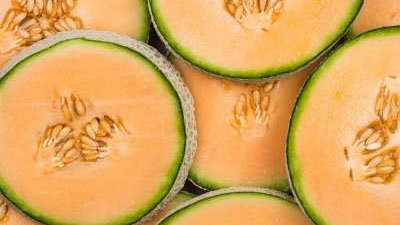How to Grow Cantaloupe (Muskmelon) in Your Garden

Summary
Cantaloupes grow best in sunny locations and in fertile, well-drained soils. Incorporate organic matter and a complete fertilizer into the area before planting. Plant 4-6 cantaloupe seeds directly in the garden when soils are 65°F. Seeds should be planted 1-2 inches deep, in mounds 4 feet apart. Thin the mounds after emergence to 2 plants. Transplant cantaloupe 2 feet apart through black plastic for early maturity. Use row covers or hot caps to protect the plants when planting before the frost-free period. After the vines develop runners, side dress with additional nitrogen fertilizer. Irrigation should be deep and infrequent. Plastic and organic mulches help conserve water and reduce weeding, however, do not apply organic mulches until soils have warmed to 75°F. Control insect and diseases throughout the year. Harvest cantaloupes when the fruits separate from the vine easily and the background color is creamy yellow. Excellent varieties include Ambrosia, Mission, Summit Hybrid, and Rocky Sweet.
Cantaloupe Varieties
Ambrosia, Classic Hybrid, Hales Best, Mission, Rocky Sweet and Summit Hybrid are excellent cantaloupe varieties.
How to Grow Cantaloupe
Soil
Cantaloupes prefer organic, rich, welldrained, sandy soils for best growth. Most soils will grow cantaloupe provided they are well-drained.
Soil Preparation
Choose a site in your garden that receives full sun. Before planting, determine fertilizer needs with a soil test and then follow the recommendations given with the test report. If fertilizer applications are warranted, work the fertilizer into the top 6 inches of soil. If you fertilize with compost, apply no more than 1 inch of well-composted organic matter per 100 square feet of garden area.
Plants
Cantaloupe can be grown from seed or transplants. Seed should be planted 1-2 inches deep. Transplants should have 2-3 mature leaves and a well-developed root system. Allow 6 weeks to grow transplants. Transplants mature about 2 weeks before seeded melons and should be used in short growing areas of Utah.
Planting and Spacing
Cantaloupe should be planted when soils are 65°F or after all frost danger has past. Plant 4-6 seeds in mounds 4 feet apart. After they have two leaves, thin to 2 plants per mound. Transplants should be planted 2 feet apart in row, with rows 4-6 feet apart. Avoid damaging the roots when planting which slows establishment and growth.
Mulch
Black plastic mulch warms the soil, conserves water and helps control weeds. Plastic mulches allow earlier planting and maturity, especially with transplants. After laying out the mulch, secure the edges with soil and cut holes for seeds or transplants. When using plastic mulches and row covers, seeds or plants can be set out about 2 weeks before the last frost date. Do not apply organic mulches (grass clippings, straw, newspapers, etc.) until soils are warmer than 75°F. Both plastic and organic mulches help conserve water and control weeds.
Row covers
Row covers enhance growth and earliness. Hotcaps, plastic tunnels, fabric covers, and other devices help protect seedlings and transplants from cool air temperatures. Use a thermometer to help determine the temperature under row covers. Plants grown under row covers require ventilation when air temperatures exceed 80°F. Covers need to be removed when plants start to flower or when temperatures exceed 90°F. Remove covers when weather has stabilized.
Irrigation
Water cantaloupe deeply and infrequently, 1-2 inches per week. Use drip irrigation if possible. Mulch around the plants will help conserve soil moisture and reduce weed growth. Irrigate so that moisture goes deeply into the soil. Reduce watering amount as the fruits ripen to improve flavor.
Fertilizer
After the vines develop runners, side dress each plant with 3-4 tablespoons of a nitrogen fertilizer (21-0-0), sprinkled around the plant, then water in the fertilizer.
Problems with Growing Cantaloupe
Weeds
Plastic and organic mulches effectively control weeds. Healthy vigorous vine growth by cantaloupe will also smother weeds.
Insects and Diseases
For more detailed information on insect and diseases visit the Utah Pests website (www.utahpests.usu.edu).
Insect |
Identification |
Control |
|---|---|---|
| Aphids | Green or black soft-bodies insects that feed on underside of leaves. Leaves become crinkled and curled. May transmit virus diseases. Secreted honeydew makes plants appear shiny, wet or sticky. | Use insecticidal soaps or strong water stream to dislodge insects. |
| Cucumber Beetles | Adults have stripes or spots and feed on leaves and vines which reduces vigor. They transmit bacterial disease. Larvae bore into roots and stems causing plants to wilt and die. | Application of chemicals at first appearance is needed to control this pest. |
Disease |
Symptom |
Control |
| Powdery Mildew | White fungal patches start on older leaves. The disease eventually spreads to all plant parts. The foliage dies, exposing fruits to the sun, which causes premature ripening. | Plant resistant varieties. |
| Wilt Diseases | Leaves wilt on one or more vines. Plants often die. Streaking, slime formation, or gummy exudates visible on stems. Diseases are caused by different pathogens. | Identify causal disease. Treat disease as recommended once identified. |
| Virus | Leaves are light green, mottled, malformed, dwarfed and curled. Early infection affects fruit shape and flavor. An aphid transmitted disease. | Control aphids. Destroy severely infected plants. |
How to Harvest and Store Cantaloupe
Cantaloupe require 35-45 days to mature from flowering, depending on the temperature and variety. Use the following guide to determine fruit maturity. The netting gets coarse and rough, the stem breaks (slips) away from the vine easily, and the background color of the fruit turns from green to yellow (see photo). Pick melons as they ripen. Cantaloupe will store for 1-2 weeks if held at 45- 50°F.
Cantaloupe Plant Productivity
Plant 3-4 cantaloupe per person for fresh use and an additional 3-4 plants for juicing or freezing. Expect 100 fruits per 100 feet of row.
Cantaloupe Nutrition
Cantaloupe are mostly water. A quarter of a melon has about 50 calories, is low in fat and is an excellent source of vitamin A and vitamin C.
Frequently Asked Questions
Why do the first blossoms drop off my muskmelon (cantaloupe) plants? The first flowers to appear on the vines are male. The female flowers, which open later, have a swelling at the base that forms the fruit. After bees pollinate these female flowers, the fruit develops.
What causes poor fruit set and low yields in cantaloupe? The failure for female flowers to set and develop melons is due to a lack of proper pollination by bees, very hot weather or water stress.
How can I grow muskmelons (cantaloupes) in a small garden? Cantaloupe plants can be trained to a fence or trellis or grown in a large pot. After the fruits begin to enlarge they will need some support or the fruit weight may damage the vines.
Do muskmelons (cantaloupes) cross-pollinate with other vine crops? No. Cantaloupe do not cross-pollinate with cucumbers, watermelon, squash or pumpkins. Different cantaloupe varieties do cross-pollinate, but the effect of this is not evident unless the seeds are saved and planted the following year.
Published May 2020
Utah State University Extension
Peer-reviewed fact sheet
Download PDF
Authors
Rick Heflebower and Dan Drost
Related Research









